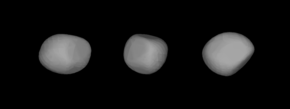 A three-dimensional model of 54 Alexandra based on its
light curve | |
| Discovery [1] | |
|---|---|
| Discovered by | H. Goldschmidt |
| Discovery date | 10 September 1858 |
| Designations | |
| (54) Alexandra | |
| Pronunciation | /ˌælɪɡˈzændrə, -ˈzɑːn-/ AL-ig-ZA(H)N-drə [2] |
Named after |
Alexander von Humboldt (German explorer) |
| Main belt | |
| Adjectives | Alexandrian |
| Orbital characteristics | |
| Epoch December 31, 2006 ( JD 2454100.5) | |
| Aphelion | 485.483 Gm (3.245 AU) |
| Perihelion | 326.043 Gm (2.179 AU) |
| 405.763 Gm (2.712 AU) | |
| Eccentricity | 0.196 |
| 1,631.620 d (4.47 a) | |
| 103.809° | |
| Inclination | 11.804° |
| 313.446° | |
| 345.594° | |
| Physical characteristics | |
| Dimensions | 160 × 135 km (± 1 km) |
Mean diameter | 154.137 km [1] |
| Mass | (6.16±3.50)×1018 kg [3] |
Mean
density | 3.50±2.11 g/cm3 [3] |
| 18.14 h [4] | |
Pole
ecliptic latitude | 155°±4° [5] |
Pole
ecliptic longitude | 17°±3° [5] |
| 0.056 [1] [6] | |
|
Tholen =
C
[1] SMASS = C [1] | |
| 7.66 [1] | |
Alexandra ( minor planet designation: 54 Alexandra) is a carbonaceous asteroid from the intermediate asteroid belt, approximately 155 kilometers in diameter. It was discovered by German-French astronomer Hermann Goldschmidt on 10 September 1858, and named after the German explorer Alexander von Humboldt; it was the first asteroid to be named after a male. [7]
Description
On May 17, 2005, this asteroid occulted a faint star ( magnitude 8.5) and the event was observed and timed in a number of locations within the U.S. and Mexico. As a result, a silhouette profile was produced, yielding a roughly oval cross-section with dimensions of 160 × 135 km (± 1 km). [8] The mass of the asteroid can be estimated based upon the mutually perturbing effects of other bodies, yielding an estimate of (6.16±3.50)×1018 kg. [3]
Photometric observations of this asteroid during 1990–92 gave a light curve with a period of 18.14 ± 0.04 hours and a brightness variation of 0.10 in magnitude. [4] Alexandra has been studied by radar. [9] It was the namesake and largest member of the former Alexandra asteroid family; a dynamic group of C-type asteroids that share similar orbital elements. Other members included 70 Panopaea and 145 Adeona. [10] 145 Adeona was subsequently assigned to the Adeona family, with Alexandra and Panopaea being dropped. [11]
In Popular Culture
In the Swedish film Aniara (2018) it is mentioned that 54 Alexandra is the closest celestial body which the off-course and out-of-control spacecraft will approach before it leaves the Solar System.
References
- ^ a b c d e f Yeomans, Donald K. "54 Alexandra". JPL Small-Body Database Browser. NASA Jet Propulsion Laboratory. Retrieved 7 April 2013.
-
^
"Alexandra".
Lexico UK English Dictionary.
Oxford University Press. Archived from
the original on 22 March 2020.
"Alexandra". Dictionary.com Unabridged (Online). n.d. - ^ a b c Carry, B. (December 2012), "Density of asteroids", Planetary and Space Science, vol. 73, pp. 98–118, arXiv: 1203.4336, Bibcode: 2012P&SS...73...98C, doi: 10.1016/j.pss.2012.03.009. See Table 1.
- ^ a b Belskaya, I. N.; et al. (November 1993), "Physical Studies of Asteroids. Part XXVII. Photoelectric Photometry of Asteroids 14 Irene, 54 Alexandra and 56 Melete", Astronomy and Astrophysics Supplement, vol. 101, no. 3, pp. 507–511, Bibcode: 1993A&AS..101..507B.
- ^ a b Hanuš, J.; et al. (May 2017), "Volumes and bulk densities of forty asteroids from ADAM shape modeling", Astronomy & Astrophysics, 601: 41, arXiv: 1702.01996, Bibcode: 2017A&A...601A.114H, doi: 10.1051/0004-6361/201629956, A114.
- ^ "Asteroid Data Sets". Archived from the original on 17 December 2009. Retrieved 12 January 2007.
- ^ Schmadel, Lutz D. (2003), Dictionary of Minor Planet Names (5th ed.), Springer, p. 20, ISBN 3642297188.
- ^ D.W. Dunham, "Upcoming Asteroid Occultations", Sky & Telescope, June, 2006, p. 63.
- ^ "Radar-Detected Asteroids and Comets". NASA/JPL Asteroid Radar Research. Retrieved 30 October 2011.
- ^ Williams, J. G. (March 1988), "The Unusual Alexandra Family", Abstracts of the Lunar and Planetary Science Conference, vol. 19, pp. 1277–1278, Bibcode: 1988LPI....19.1277W.
- ^ Zappala, Vincenzo; et al. (December 1990), "Asteroid families. I - Identification by hierarchical clustering and reliability assessment", Astronomical Journal, vol. 100, pp. 2030–2046, 2045, Bibcode: 1990AJ....100.2030Z, doi: 10.1086/115658. See p. 2045 and family 44.
External links
- Lightcurve plot of 54 Alexandra, Palmer Divide Observatory, B. D. Warner (2008)
- Asteroid Lightcurve Database (LCDB), query form ( info Archived 16 December 2017 at the Wayback Machine)
- Dictionary of Minor Planet Names, Google books
- Asteroids and comets rotation curves, CdR – Observatoire de Genève, Raoul Behrend
- Discovery Circumstances: Numbered Minor Planets (1)-(5000) – Minor Planet Center
- 54 Alexandra at AstDyS-2, Asteroids—Dynamic Site
- 54 Alexandra at the JPL Small-Body Database